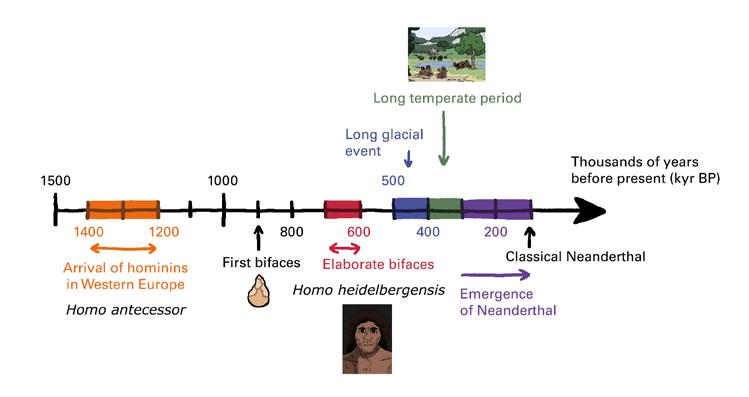doi.org/10.22498/pages.horiz.2.4
Can climate change humankind?
This may have happened 450,000 years ago during a long climate-temperate period Marie-Hélène Moncel; illustrations: Quentin Girardclos
450,000 years ago, a long period of temperate climate (relatively warm in comparison to the current one) took place and lasted about 50,000 years. During this time interval, major changes in the anatomy of hominins occurred, with the appearance of Neanderthal. Hominins living in Europe developed stone tools and hunting methods among other cultural adaptations. Their population probably doubled in size, and they occupied larger territories. This long temperate period, also known as Marine Isotope Stage 11, appears to have been a time where innovative behaviors (such as stone tools) flourished and promoted expansion of populations across Europe. The impacts of climate on human culture is currently a very hot topic, and understanding how our ancestors adapted their culture in response to climatic variability is highly relevant to how we evaluate our own ability to adapt to present-day climate change. Figure 1. Timeline of the prehistory of Europe. The dates are approximate, due to uncertainties in the dating methods that were used. Information about the climate is provided above, in particular the long temperate period of 450-400 thousand years ago. Below: some key dates related to hominin evolution, including first bifaces, large pointed tools made on two faces, indicating new hominin ability in making stone tools.
4
PAGES HORIZONS • VOLUME 2 • 2022
Beginning of human presence in Europe The earliest traces of humans in Europe are often compared to those observed in the African archaeological records, where tools have been found and dated to 3.3 million years ago. In Europe, the earliest tools have been dated to around 1.4–1.2 million years ago (Fig. 1). Because humans migrating from Africa to Europe would have brought tools (or at least the knowledge of how to create tools!) with them, it is likely that small groups of hominins entered Europe from the Near East at this time, when the climate was temperate and humid. These groups mainly stayed in southern Europe, but there are indications of occupations at higher latitudes, for example in southern England, earlier than 900,000 years ago, when continental conditions were milder and allowing hominins to survive and thrive in this area. This part of England has never been covered by ice sheets*, even during glacial events* when ice sheets in other parts of the world were larger and thicker than today, and some traces of early humans have been preserved. Paleoanthropologists have assigned the name of Homo antecessor to these first Europeans.














